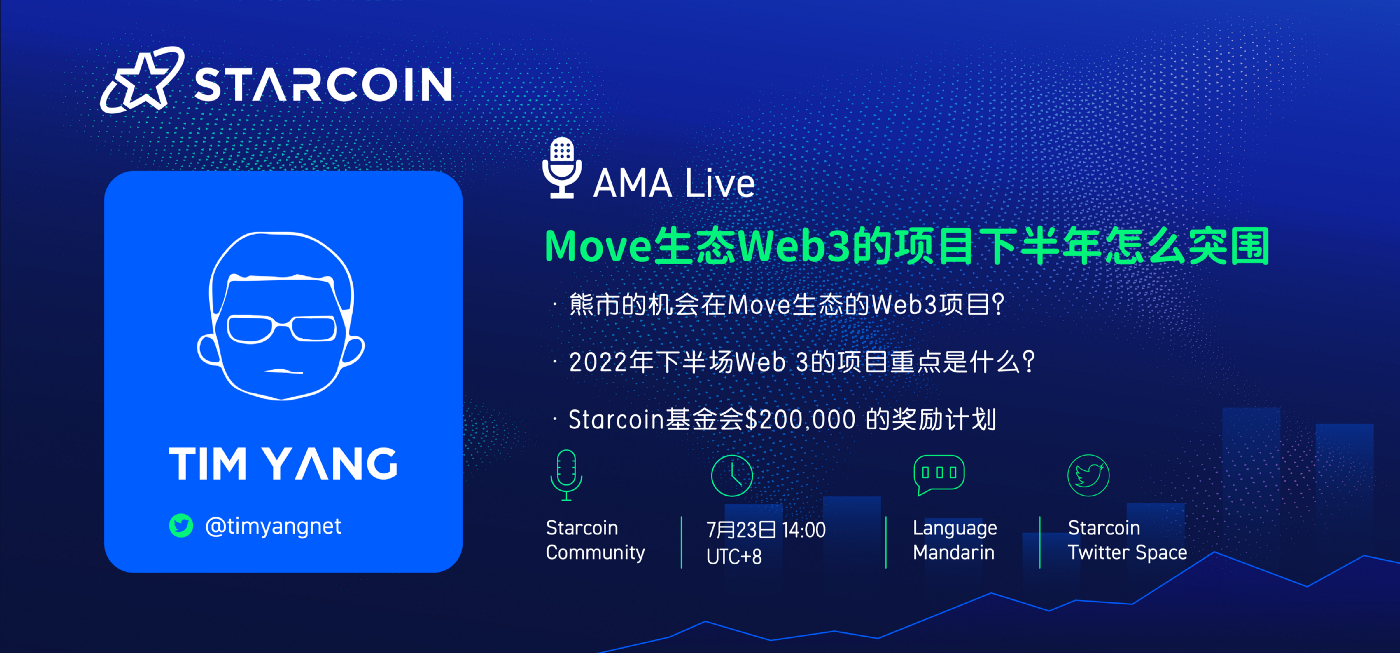Recap Move & Starcoin [AMA 07.23.2022]
Published at July 26, 2022 By Starcoin.

What is Move specifically referred to often in the Web3 space, and what does it mean?
Tim:
This has 3 levels of implications.
- Move language. Move is a smart contract language designed specifically for digital assets, which provides security for digital assets while being advanced in its programming model.
- Move VM. Move VM is the runtime environment for Move, which provides runtime security checks and enhanced protection for digital assets.
- Move Application Ecosystem: Move Ecosystem refers to smart contracts and Web3 applications developed using the Move language, which can run on multiple chains after simple adaptation and can fully enjoy the power of the Move language and the protection of the Move VM.
What does Starcoin have to do with Move?
Tim:
Starcoin is a proof-of-work blockchain that enables secure smart contracts to power services in decentralized finance, gaming and NFTs.
Starcoin is the first permissionless blockchain based on the Move system and leverages the powerful features of Move while also enabling significant unique design features.
- With the easy gas mechanism, users can use any token on the platform to pay for gas
- auto accept token feature to prevent spoofing and spamming by airdrop mechanism
- The first Map(table) function in the Move language
- The first Move ecosystem to implement the governance mechanism of automatic chain upgrade through voting, which is also leading in the whole industry.
Recently, the move ecology L1 has exploded, including Aptos, Sui, etc. How do you view the development of these new public chains?
Tim:
We have noticed that several Move chains are solving an infrastructure performance level problem. To build an infrastructure that caters to the needs of the future Web3 era.
However, we are all taking different routes.Aptos and Sui’s approach is to optimize L1, including improving the consensus algorithm and enhancing the parallel processing capability of nodes, so that the TPS of L1 can reach 100,000 or even higher;
Starcoin adopts a different route, Starcoin L1 mainly focuses on solving decentralization and security problems, and higher performance is achieved through L2.
There is no simple conclusion about the advantages and disadvantages of these routes, but it is also a widely accepted attempt to solve the scalability problem in the industry.
What are the innovations in Starcoin L2’s scalability solution?
Tim:
Layer 2 is evolving fast and solves the scalability problem of Layer 1 very well, but if we consider it in the context of Web3, there are two problems.
- Layer 2 does not solve the problem of composability and interactivity between smart contracts; each Layer 2 is an isolated island. Users need to use a mechanism similar to the cross-chain bridge to allow token flow between layer 1 and layer 2. At the same time, the current Layer 2 also has the problem of liquidity fragmentation from the market makers’ perspective.
- There is a performance ceiling for Layer 2 scaling. Since Layer 2 needs to rely on Layer 1 to keep rollup data, multiple Layer 2s are competing with Layer 1’s access resources, so there is a performance ceiling for Layer 2 scaling.
Starcoin is a hierarchical blockchain network designed from scratch so that multiple layers can be seamlessly integrated and achieve the composability and interactivity of protocols. In addition, to address the performance ceiling of Layer 2, Starcoin has further Layer 3 solutions to achieve true scalability with no performance ceiling.
What progress has Starcoin made in the past year?
Tim:
- Developed Oracle, NFT and other standards in the Move space
- Launched the first Move-EVM cross-chain bridge
- Launched the first Move Layer 2 rollup to implement OMO
- Launched the first Move Dapp including Starswap(DEX), BFly(Stablecoin), Kiko(Metaverse), etc.
- First SBT-based DAO in the Move space
What opportunities does Move have for users in 2022?
Tim:
For general users: you can tap into high-yield DeFi projects like Starcoin eco Starswap, or participate in test network incentives for new Move eco projects like Aptos, Sui, etc.
For developers: Move is still in an early stage of the ecosystem, so enter now to enjoy the dividends of the track. There are 2 ideas for developers to take advantage of the Move opportunity, one is to port mature applications from other chains to the Move ecosystem; or to innovate by taking advantage of Move’s unique advantages.
What are the recent marketing incentives for Starcoin?
According to the roadmap update announced last week, Starcoin will next have $200,000 worth of Grants for developer support. Interested developers can apply at http://grant.starcoin.org .